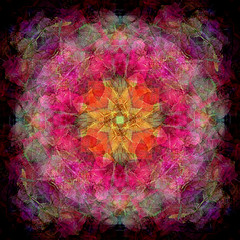 Migraine sufferers are generally broken down into two categories: migraines with aura and migraines without aura. Migraine auras happen to 20 percent of people who experience migraines.
Migraine sufferers are generally broken down into two categories: migraines with aura and migraines without aura. Migraine auras happen to 20 percent of people who experience migraines.
The Aura Phase
There are four phases of migraines, although not everyone experiences aura. Aura is the second phase in migraines with aura. It is a warning sign that generally comes an hour before the migraine or sooner. You can also experience aura during the attack itself.
The National Migraine Association explains that the aura comes with many visual symptoms like seeing stars, flashes, blind spots and other vision disturbances. You can also experience symptoms with other senses like trouble with speech, confusion or prickling skin.
The Science Behind the Aura
The exact cause(s) of aura are not known. However, there are a number of theories on the subject. These include:
-
genetics
-
brain chemical irregularities causing the immune system and the brain to overreact
-
being overweight
Research from the National Institute of Neurological Disorders and Stroke has found that the aura occurs when the brain has increased activity and then decreased activity. This activity can go to the vision part of the brain and is associated with the visual aura. This process is called cortical spreading depression, but researchers do not fully understand why it occurs. In addition, research has found that migraines with aura seem to be connected to a short-term oxygen level drop from the cortical spreading depression that creates small areas of brain damage similar to a stroke.
Current Research
More research is needed on migraines. This is shown by scientists not understanding the causes of the aura phase. Nonetheless, some studies are conducted on the subject, including on migraines with aura.
The Migraine Research Foundation is one of the main organizations that conducts research on migraines. It has found that women have an increased risk of experiencing migraine with aura when they are pregnant, before menstruation or during other times with high neurosteroid levels. In addition, it found that migraines with aura are associated with a higher risk of cardiovascular disease, ischemic stroke in particular. The Foundation also studies cortical spreading depression and other aspects of aura.
The National Institute of Neurological Disorders and Stroke conducts and supports research on migraines. One of its studies is researching the relationship between migraine with aura and metabolism and neurophysiological function. A study on aura is focused on parts of the visual cortex and their relationship to the aura. Additional research strives to find treatments to stop the aura.
Recent studies presented at the March 2013 American Academy of Neurology’s 65th Annual Meeting showed information on women with migraines with aura. One found that these women can develop cardiovascular problems like strokes and heart attacks, and the other found that women with migraine with aura who take hormone contraceptives have an increased risk of blood clot complications.
If you suffer from migraines, you might consider taking part in a clinical trial to help researchers learn more about migraines and treatments for them.
Famous People Who Have Experienced Aura
If you experience migraine auras, you’re in the company of numerous famous people who have experienced them throughout time. Here are a few instances:
-
Lewis Carroll supposedly wrote Alice in Wonderland based on his experiences with migraine auras.
-
While some theories believe that Vincent Van Gogh’s paintings were from insanity or other causes, some believe they came from migraine auras.
-
Another painter, Georges Seurat, painted images with dots of color reminiscent of auras; the Seurat effect to describe auras is named after him.
Social Stigma
Migraines, and especially the symptoms that come with migraine with aura, can come with social stigma, which means that people judge with discrimination and prejudice based on migraines and their symptoms.
Many people do not understand migraines or believe they are a real illness. People with migraines tend to internalize these ideas and give themselves a hard time when they are experiencing migraine symptoms.
A study, released online on January 16, 2013, of chronic migraine, episodic migraine and epilepsy backed up the feelings migraineurs feel from social stigma. The study found that stigma was associated with the inability to work in particular, especially among chronic migraine sufferers.
What to Do When You Experience Aura
Aura is a warning sign of an upcoming migraine, so it gives you time to try to prevent or manage the migraine. It can be the right time to take medication to block the attack from happening.
Take advantage of this time to take pain relievers, cold compresses, pressure, and other prescription medications you usually take when you experience migraines. You can also stay somewhere where it is dark and quiet. For migraine relief, you could also practice calming techniques like deep breathing, meditation and calming, restorative yoga poses.
Image Credit: qthomasbower

